The Impacts of Climate Change on Aircraft Noise near European Airports
Abstract
1. Introduction
2. Materials and Methods
2.1. Sound Propagation Model
- 1.
- The overall sound pressure level (OPSL) range reported for the A320 is the smallest of any of the aircraft types considered, with an interquartile range (itself larger than the standard deviation of a normal distribution) of just ≃1 dB.
- 2.
- The only frequency range in which a good agreement between total (modelled) and measured noise occurs is above the frequency range considered by this study in the regime where fan noise dominates. For lower frequencies, the disparity can be as large as ≈20 dB, depending on the take-off speed, which is itself yet another uncertainty contributor.
2.2. Motivation and Utility of the Current Model
3. Effect of Climate Change on Climb Angle
4. Parameter Uncertainty and Latin Hypercube Parameter Sampling
5. Results
5.1. Example Noise Contours
5.2. Effect of Atmospheric Conditions on
5.3. Climate Change Impacts on Residential Populations near Airports
6. Recommendations for Future Model Development
7. Conclusions
Author Contributions
Funding
Data Availability Statement
Acknowledgments
Conflicts of Interest
Abbreviations
| AEDT | Aviation Environmental Design Tool |
| ANCON | Aircraft Noise Contour (model) |
| CMIP6 | 6th Coupled Model Intercomparison Project |
| EASA | European Union Aviation Safety Agency |
| FAMOUS | Fast Met Office/UK Universities Simulator |
| HadCM3 | Hadley Centre Coupled Model version 3 |
| ICAO | International Civil Aviation Organisation |
| IMPACT | Integrated Aircraft Noise and Emissions Modelling Platform |
| INM | Integrated Noise Model |
| IPCC | Intergovernmental Panel on Climate Change |
| ISA | International Standard Atmosphere |
| LHS | Latin hypercube Sampling |
| SSP | Shared Socioeconomic Pathway |
Appendix A. Mathematical Symbols Used
| Symbol | Definition |
|---|---|
| I | Sound intensity |
| r | Distance from sound source |
| Air density | |
| Air density under International Standard Atmosphere conditions at sea level | |
| P | Pressure |
| Coefficient of sound absorption | |
| Heat capacity at constant pressure and density respectively. | |
| Angle over which noise anisotropy is calculated | |
| Empirical scaling parameter controlling the shape of the noise anisotropy | |
| Specific gas constant for air | |
| Climb angle | |
| Thrust | |
| Temperature in Kelvin at 0 °C | |
| D | Drag |
| W | Weight |
| Day–evening–night noise level from IMPACT | |
| Area enclosed by the 50 dB SPL contour in the emulator | |
| Area enclosed by the 50 dB contour in the IMPACT model |
Appendix B. Absolute Population Changes
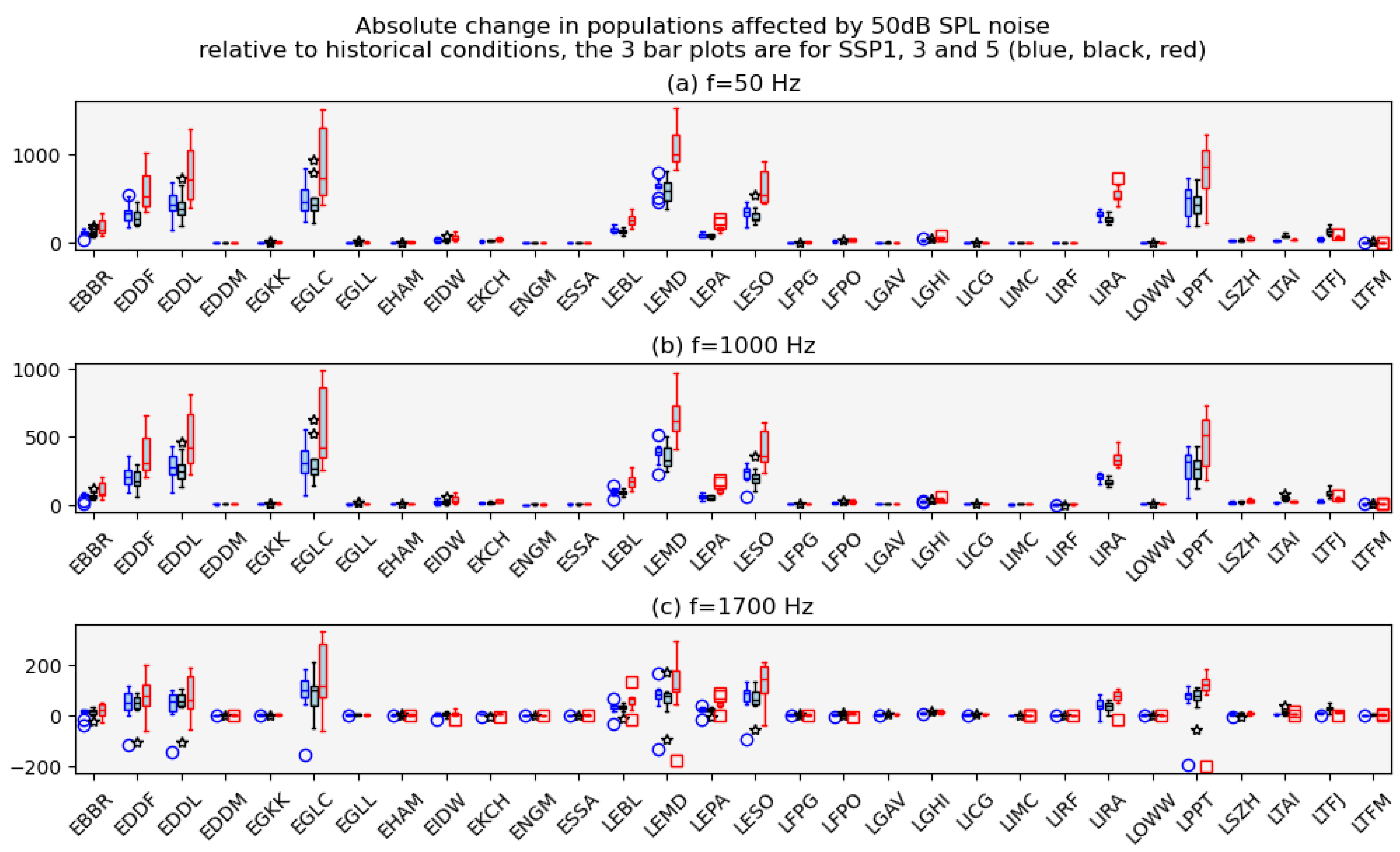
References
- Williams, J.; Williams, P.D.; Guerrini, F.; Venturini, M. Quantifying the Effects of Climate Change on Aircraft Take-Off Performance at European Airports. Aerospace 2025, 12, 165. [Google Scholar] [CrossRef]
- Padhra, A.; Rapsomanikis, S.; Gratton, G.; Williams, P.D. The Impacts of Climate Change on Aircraft Noise Near Airports. In Proceedings of the 4th International Aviation Management Conference (IAMC 2022), Dubai, United Arab Emirates, 21–22 November 2022; Available online: https://repository.uwl.ac.uk/id/eprint/9425/3/Manuscript%20-%20IAMC-SP408%20-%20Final%20Version.pdf (accessed on 28 August 2025).
- Caserini, S.; Giani, P.; Cacciamani, C.; Ozgen, S.; Lonati, G. Influence of climate change on the frequency of daytime temperature inversions and stagnation events in the Po Valley: Historical trend and future projections. Atmos. Res. 2017, 184, 15–23. [Google Scholar] [CrossRef]
- Hole, L.R.; Hauge, G. Simulation of a morning air temperature inversion break-up in complex terrain and the influence on sound propagation on a local scale. Appl. Acoust. 2003, 64, 401–414. [Google Scholar] [CrossRef]
- European Union Aviation Safety Agency (EASA). European Aviation Environmental Report. Available online: https://www.easa.europa.eu/en/domains/environment/eaer (accessed on 19 May 2025).
- Stansfeld, S. Airport noise and cardiovascular disease. Br. Med J. 2013, 347, f5752. [Google Scholar] [CrossRef]
- Black, D.A.; Black, J.A.; Issarayangyun, T.; Samuels, S.E. Aircraft noise exposure and resident’s stress and hypertension: A public health perspective for airport environmental management. J. Air Transp. Manag. 2007, 13, 264–276. [Google Scholar] [CrossRef]
- Alquezar, R.D.; Macedo, R.H. Airport noise and wildlife conservation: What are we missing? Perspect. Ecol. Conserv. 2019, 17, 163–171. [Google Scholar] [CrossRef]
- Dominoni, D.M.; Greif, S.; Nemeth, E.; Brumm, H. Airport noise predicts song timing of European birds. Ecol. Evol. 2016, 6, 6151–6159. [Google Scholar] [CrossRef]
- International Civil Aviation Organization. Review of Noise Abatement Procedure Research & Development and Implementation Results. 2007. Available online: https://www.icao.int/sites/default/files/sp-files/environmental-protection/Documents/ReviewNADRD.pdf (accessed on 10 February 2025).
- Bhanpato, J.; Puranik, T.G.; Mavris, D.N. Data-Driven Analysis of Departure Procedures for Aviation Noise Mitigation. Eng. Proc. 2021, 13, 2. [Google Scholar] [CrossRef]
- Ollerhead, J. The CAA Aircraft Noise Contour Model: ANCON Version 1; UK Civil Aviation Authority: West Sussex, UK, 1992; Available online: https://www.caa.co.uk/publication/download/12410 (accessed on 28 August 2025).
- Boeker, E.R.; Dinges, E.; He, B.; Fleming, G.; Roof, C.J.; Gerbi, P.J.; Rapoza, A.S.; Hermann, J. Integrated Noise Model (INM) Version 7.0 Technical Manual. Federal Aviation Administration, Office of Environment and Energy. 2008. Available online: https://rosap.ntl.bts.gov/view/dot/12188 (accessed on 28 August 2025).
- Aviation Environmental Design Tool (AEDT) Version 3g Technical Manual. Technical Report. U.S. Department of Transportation; Federal Aviation Administration, Office of Environment and Energy. 2024. Available online: https://aedt.faa.gov/Documents/AEDT3g_UserManual.pdf (accessed on 28 August 2025).
- EUROCONTROL. Integrated Aircraft Noise and Emissions Modelling Platform (IMPACT). 2025. Available online: https://www.eurocontrol.int/platform/integrated-aircraft-noise-and-emissions-modelling-platform (accessed on 20 May 2025).
- Torija, A.J.; Self, R.H.; Flindell, I.H. Airport noise modelling for strategic environmental impact assessment of aviation. Appl. Acoust. 2018, 132, 49–57. [Google Scholar] [CrossRef]
- Pretto, M.; Giannattasio, P.; Gennaro, M.D.; Zanon, A.; Kuehnelt, H. Forecasts of future scenarios for airport noise based on collection and processing of web data. Eur. Transp. Res. Rev. 2020, 12, 4. [Google Scholar] [CrossRef]
- van der Grift, R.C.; Snellen, M.; Amiri-Simkooei, A. The effect of using N1% as input for aircraft noise modelling. Transp. Res. Part D Transp. Environ. 2025, 142, 104710. [Google Scholar] [CrossRef]
- Jones, C.; Gregory, J.; Thorpe, R.; Cox, P.; Murphy, J.; Sexton, D.; Valdes, P. Systematic optimisation and climate simulation of FAMOUS, a fast version of HadCM3. Clim. Dyn. 2005, 25, 189–204. [Google Scholar] [CrossRef]
- Gordon, C.; Cooper, C.; Senior, C.A.; Banks, H.; Gregory, J.M.; Johns, T.C.; Mitchell, J.F.; Wood, R.A. The simulation of SST, sea ice extents and ocean heat transports in a version of the Hadley Centre coupled model without flux adjustments. Clim. Dyn. 2000, 16, 147–168. [Google Scholar] [CrossRef]
- Castruccio, S.; McInerney, D.J.; Stein, M.L.; Crouch, F.L.; Jacob, R.L.; Moyer, E.J. Statistical Emulation of Climate Model Projections Based on Precomputed GCM Runs. J. Clim. 2014, 27, 1829–1844. [Google Scholar] [CrossRef]
- Gregoire, L.J.; Valdes, P.J.; Payne, A.J.; Kahana, R. Optimal tuning of a GCM using modern and glacial constraints. Clim. Dyn. 2011, 37, 705–719. [Google Scholar] [CrossRef]
- Virtanen, P.; Gommers, R.; Oliphant, T.E.; Haberland, M.; Reddy, T.; Cournapeau, D.; Burovski, E.; Peterson, P.; Weckesser, W.; Bright, J.; et al. SciPy 1.0: Fundamental Algorithms for Scientific Computing in Python. Nat. Methods 2020, 17, 261–272. [Google Scholar] [CrossRef]
- Bass, H.E.; Sutherland, L.C.; Zuckerwar, A.J.; Blackstock, D.T.; Hester, D.M. Atmospheric absorption of sound: Further developments. J. Acoust. Soc. Am. 1995, 97, 680–683. [Google Scholar] [CrossRef]
- Merino-Martinez, R.; Besnea, I.; von den Hoff, B.; Snellen, M. Psychoacoustic Analysis of the Noise Emissions from the Airbus A320 Aircraft Family and its Nose Landing Gear System. In Proceedings of the 30th AIAA/CEAS Aeroacoustics Conference, Rome, Italy, 4–7 June 2024; pp. 1–16. [Google Scholar] [CrossRef]
- Alves, J.A.; Paiva, F.N.; Silva, L.T.; Remoaldo, P. Low-Frequency Noise and Its Main Effects on Human Health—A Review of the Literature between 2016 and 2019. Appl. Sci. 2020, 10, 5205. [Google Scholar] [CrossRef]
- Kandula, M.; Vu, B. On the Scaling Laws for Jet Noise in Subsonic and Supersonic Flow. In Proceedings of the 9th AIAA/CEAS Aeroacoustics Conference and Exhibit, American Institute of Aeronautics and Astronautics, Hilton Head, SC, USA, 12–14 May 2003. [Google Scholar] [CrossRef]
- Bozak, R.F.J. Advanced Noise Control Fan Aerodynamic Performance; Technical Memorandum NASA/TM-2009-215807; NASA Glenn Research Center: Cleveland, OH, USA, 2009. Available online: https://ntrs.nasa.gov/api/citations/20090042818/downloads/20090042818.pdf (accessed on 28 August 2025).
- Morris, P.J.; Viswanathan, K. Jet Noise. In Noise Sources in Turbulent Shear Flows: Fundamentals and Applications; CISM International Centre for Mechanical Sciences, Courses and Lectures; Springer International Publishing: Berlin/Heidelberg, Germany, 2013; Volume 545, pp. 119–196. [Google Scholar] [CrossRef]
- Malbéqui, P.; Rozenberg, Y.; Bulté, J. Aircraft Noise Prediction in the IESTA Program. In Proceedings of the European Conference for Aerospace Sciences (EUCASS), ONERA, Châtillon Cedex, France, 6–9 July 2009. [Google Scholar]
- Sjögren, O.; Grönstedt, T.; Lundbladh, A.; Xisto, C. Fan Stage Design and Performance Optimization for Low Specific Thrust Turbofans. Int. J. Turbomach. Propuls. Power 2023, 8, 53. [Google Scholar] [CrossRef]
- Spakovszky, Z.S. Advanced low-noise aircraft configurations and their assessment: Past, present, and future. CEAS Aeronaut. J. 2019, 10, 137–157. [Google Scholar] [CrossRef]
- McAninch, G.L.; Shepherd, K.P. On INM’s Use of Corrected Net Thrust for the Prediction of Jet Aircraft Noise; Technical Memorandum NASA/TM–2011-217177; NASA Langley Research Center: Hampton, VA, USA, 2011. [Google Scholar]
- Vieira, A.; von den Hoff, B.; Snellen, M.; Simons, D. Comparison of Semi-Empirical Noise Models with Flyover Measurements of Operating Aircraft. J. Aircr. 2022, 59, 1574–1587. [Google Scholar] [CrossRef]
- Xue, R.; Jiang, J.; Zheng, X.; Gong, J.l.; Jackson, A. Study of Noise Reduction Based on Optimal Fan Outer Pressure Ratio and Thermodynamic Performance for Turbofan Engines at Conceptual Design Stage. Int. J. Aeronaut. Space Sci. 2019, 21, 439–450. [Google Scholar] [CrossRef]
- Zaporozhets, O.; Tokarev, V.; Attenborough, K. Aircraft noise characteristics on the ground and in the atmosphere. J. Sound Vib. 2014, 333, 1043–1064. [Google Scholar] [CrossRef]
- Lyu, B.; Dowling, A.P.; Naqavi, I. Prediction of installed jet noise. J. Fluid Mech. 2017, 811, 234–268. [Google Scholar] [CrossRef]
- Clark, I.A.; Nesbitt, E.H.; Thomas, R.H.; Guo, Y. Turbofan Inlet-Radiated Broadband Acoustic Flight Effects. In Proceedings of the AIAA Aviation Forum, Las Vegas, NV, USA, 21–25 July 2025. [Google Scholar] [CrossRef]
- Khavaran, A.; Bridges, J. Modeling of Turbulence Generated Noise in Jets; Technical Memorandum NASA/TM—2004-213105; NASA Glenn Research Center: Cleveland, OH, USA, 2004. Available online: https://ntrs.nasa.gov/api/citations/20040086533/downloads/20040086533.pdf (accessed on 28 August 2025).
- Airbus, S.A.S. A320 Aircraft Characteristics—Airport and Maintenance Planning, 44th ed.; Airbus S.A.S.: Blagnac Cedex, France, 2024; Available online: https://aircraft.airbus.com/sites/g/files/jlcbta126/files/2025-01/AC_A320_0624.pdf (accessed on 10 June 2025).
- UK Research and Innovation, Swindon, UK. Draft UKRI Research Data Policy. Draft Policy for Consultation. 2025. Available online: https://engagementhub.ukri.org/ukri-openresearch/developing-ukris-research-data-policy/user_uploads/draft-ukri-research-data-policy-for-consultation_published-09-april-2025.pdf (accessed on 28 August 2025).
- O’Neill, B.C.; Tebaldi, C.; van Vuuren, D.P.; Eyring, V.; Friedlingstein, P.; Hurtt, G.; Knutti, R.; Kriegler, E.; Lamarque, J.F.; Lowe, J.; et al. The Scenario Model Intercomparison Project (ScenarioMIP) for CMIP6. Geosci. Model Dev. 2016, 9, 3461–3482. [Google Scholar] [CrossRef]
- Eyring, V.; Bony, S.; Meehl, G.A.; Senior, C.A.; Stevens, B.; Stouffer, R.J.; Taylor, K.E. Overview of the Coupled Model Intercomparison Project Phase 6 (CMIP6) experimental design and organization. Geosci. Model Dev. 2016, 9, 1937–1958. [Google Scholar] [CrossRef]
- World Meteorological Organization, Geneva, Switzerland. WMO Confirms 2024 as Warmest Year on Record at About 1.55 °C Above Pre-Industrial Level. 2025. Available online: https://wmo.int/news/media-centre/wmo-confirms-2024-warmest-year-record-about-155degc-above-pre-industrial-level (accessed on 22 July 2025).
- Takahashi, T.T.; Sóbester, A. Climb Performance Anomalies in ‘Real’ Atmospheric Conditions. In Proceedings of the AIAA, Dallas, TX, USA, 17–21 June 2019. [Google Scholar] [CrossRef]
- Gratton, G.; Padhra, A.; Rapsomanikis, S.; Williams, P.D. The impacts of climate change on Greek airports. Clim. Chang. 2020, 160, 219–231. [Google Scholar] [CrossRef]
- Marchman, J.F., III. Aerodynamics and Aircraft Performance, 3rd ed.; University Libraries at Virginia Tech.: Blacksburg, VA, USA, 2021; Chapter 4; Available online: https://pressbooks.lib.vt.edu/aerodynamics/ (accessed on 28 August 2025).
- Filippone, A. Aircraft noise prediction. Prog. Aerosp. Sci. 2014, 68, 27–63. [Google Scholar] [CrossRef]
- Roca-Barceló, A.; Nardocci, A.; de Aguiar, B.S.; Ribeiro, A.G.; Failla, M.A.; Hansell, A.L.; Cardoso, M.R.; Piel, F.B. Risk of cardiovascular mortality, stroke and coronary heart mortality associated with aircraft noise around Congonhas airport, São Paulo, Brazil: A small-area study. Environ. Health 2021, 20, 59. [Google Scholar] [CrossRef]
- Baudin, C.; Lefèvre, M.; Champelovier, P.; Lambert, J.; Laumon, B.; Evrard, A.S. Self-rated health status in relation to aircraft noise exposure, noise annoyance or noise sensitivity: The results of a cross-sectional study in France. BMC Public Health 2021, 21, 116. [Google Scholar] [CrossRef]
- Purdue University Department of Chemistry. Noise Sources and Their Effects. 2000. Available online: https://www.chem.purdue.edu/chemsafety/Training/PPETrain/dblevels.htm (accessed on 16 May 2025).
- European Civil Aviation Conference (ECAC). Report on Standard Method of Computing Noise Contours Around Civil Airports. 2016. Volume 2: Technical Guide; ECAC.CEAC Doc 29. Available online: https://www.ecac-ceac.org/images/documents/ECAC-Doc_29_4th_edition_Dec_2016_Volume_2.pdf (accessed on 28 August 2025).
- Directive 2002/49/EC of the European Parliament and of the Council of 25 June 2002 relating to the assessment and management of environmental noise. Off. J. Eur. Communities 2002, L 189, 12–25. Available online: https://eur-lex.europa.eu/legal-content/EN/TXT/PDF/?uri=CELEX:32002L0049 (accessed on 28 August 2025).
- Huang, J.; Zheng, L. Noise analysis of the turbojet and turbofan engine tests. Proc. Inst. Mech. Eng. Part G 2014, 228, 2414–2423. [Google Scholar] [CrossRef]
- Tlałka, F.; Rzucidło, P. Modeling and Analysis of Noise Emission Using Data from Flight Simulators. Appl. Sci. 2023, 13, 10324. [Google Scholar] [CrossRef]
- Sahai, A.K.; Snellen, M.; Simons, D.G.; Stumpf, E. Aircraft Design Optimization for Lowering Community Noise Exposure Based on Annoyance Metrics. J. Aircr. 2017, 54, 3421–3432. [Google Scholar] [CrossRef]
- Federal Aviation Administration. Basics of Aircraft Noise. 2022. Available online: https://www.faa.gov/regulations_policies/policy_guidance/noise/basics (accessed on 11 June 2025).
- Olén, N.B.; Lehsten, V. High-resolution global population projections dataset developed with CMIP6 RCP and SSP scenarios for year 2010–2100. Data Brief 2022, 40, 107804. [Google Scholar] [CrossRef]
- Reybrouck, M.; Podlipniak, P.; Welch, D. Music and Noise: Same or Different? What Our Body Tells Us. Front. Psychol. 2019, 10, 1153. [Google Scholar] [CrossRef]
- Ban, N.; Caillaud, C.; Coppola, E.; Pichelli, E.; Sobolowski, S.; Adinolfi, M.; Ahrens, B.; Alias, A.; Anders, I.; Bastin, S.; et al. The first multi-model ensemble of regional climate simulations at kilometer-scale resolution, part I: Evaluation of precipitation. Clim. Dyn. 2021, 57, 275–302. [Google Scholar] [CrossRef]
- Mashhoodi, B.; van Timmeren, A. Airport location in European airport regions: Five typologies based on the regional road network and land use data. Data Brief 2020, 33, 105317. [Google Scholar] [CrossRef]
- European Commission. Urbanisation in Europe. 2020. Available online: https://knowledge4policy.ec.europa.eu/foresight/topic/continuing-urbanisation/urbanisation-europe_en (accessed on 24 July 2025).
- European Commission. Continuing Urbanisation. 2023. Available online: https://knowledge4policy.ec.europa.eu/continuing-urbanisation_en (accessed on 24 July 2025).
- Wolfe, P.J.; Kramer, J.L.; Barrett, S.R. Current and future noise impacts of the UK hub airport. J. Air Transp. Manag. 2017, 58, 91–99. [Google Scholar] [CrossRef]
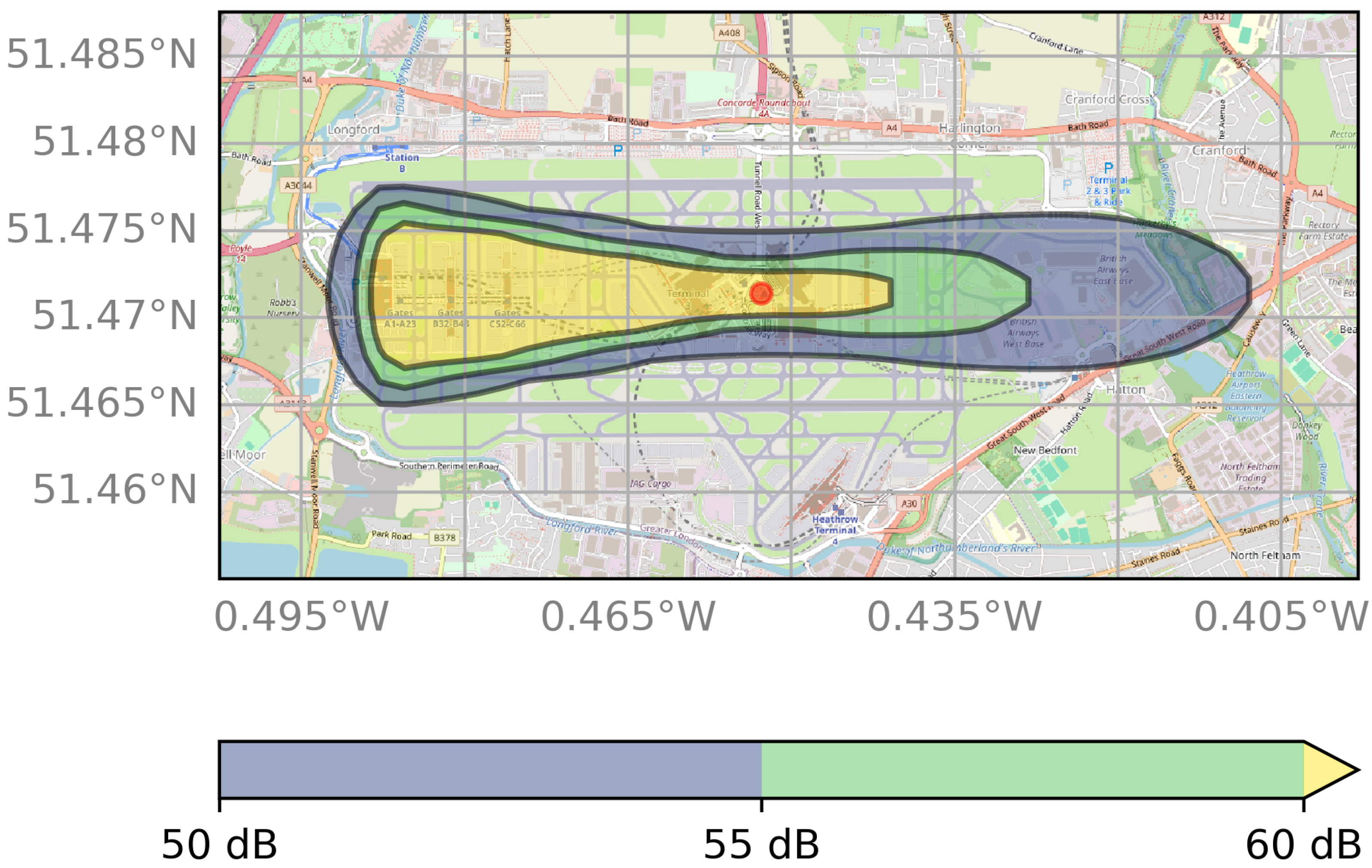

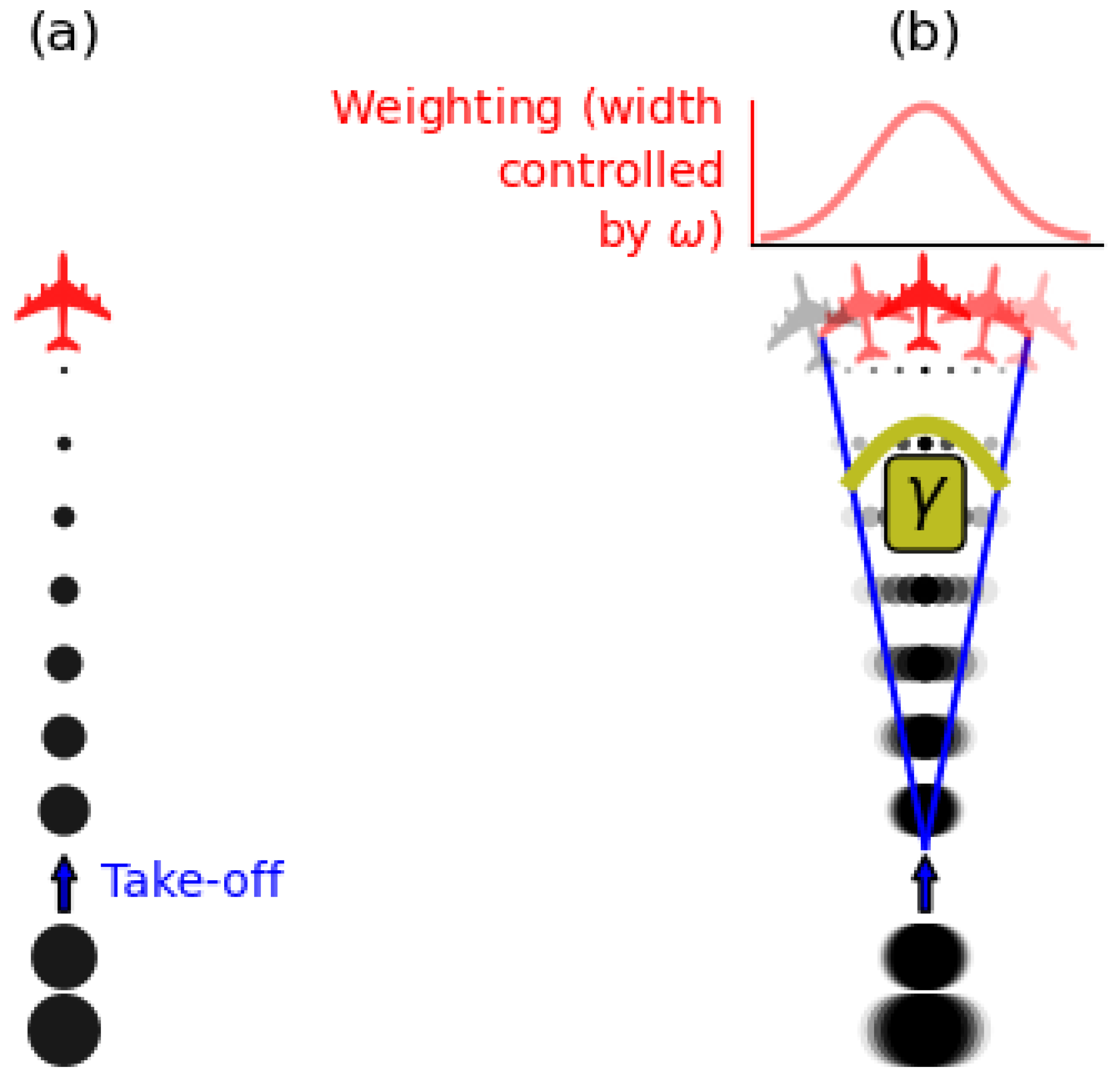

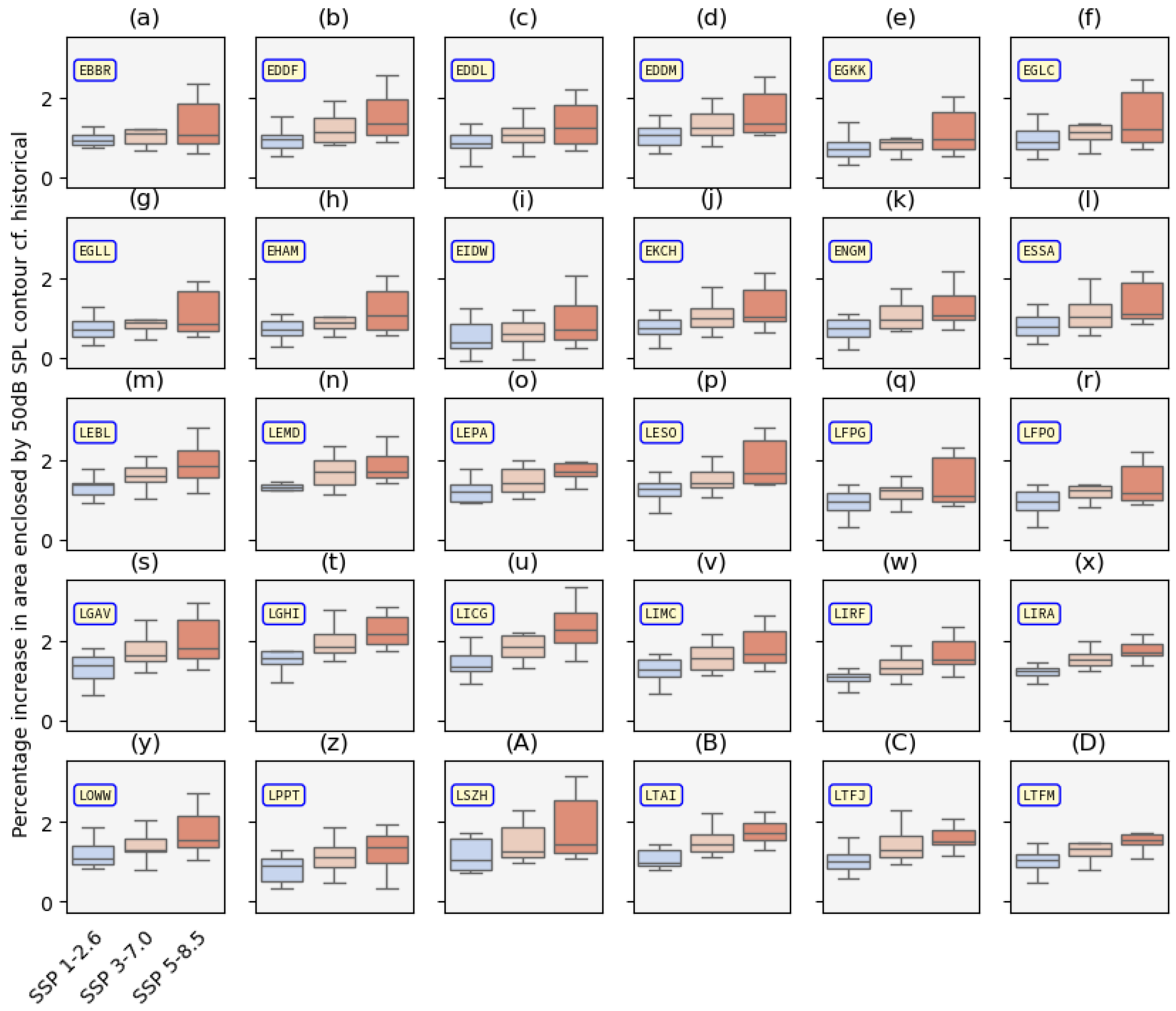
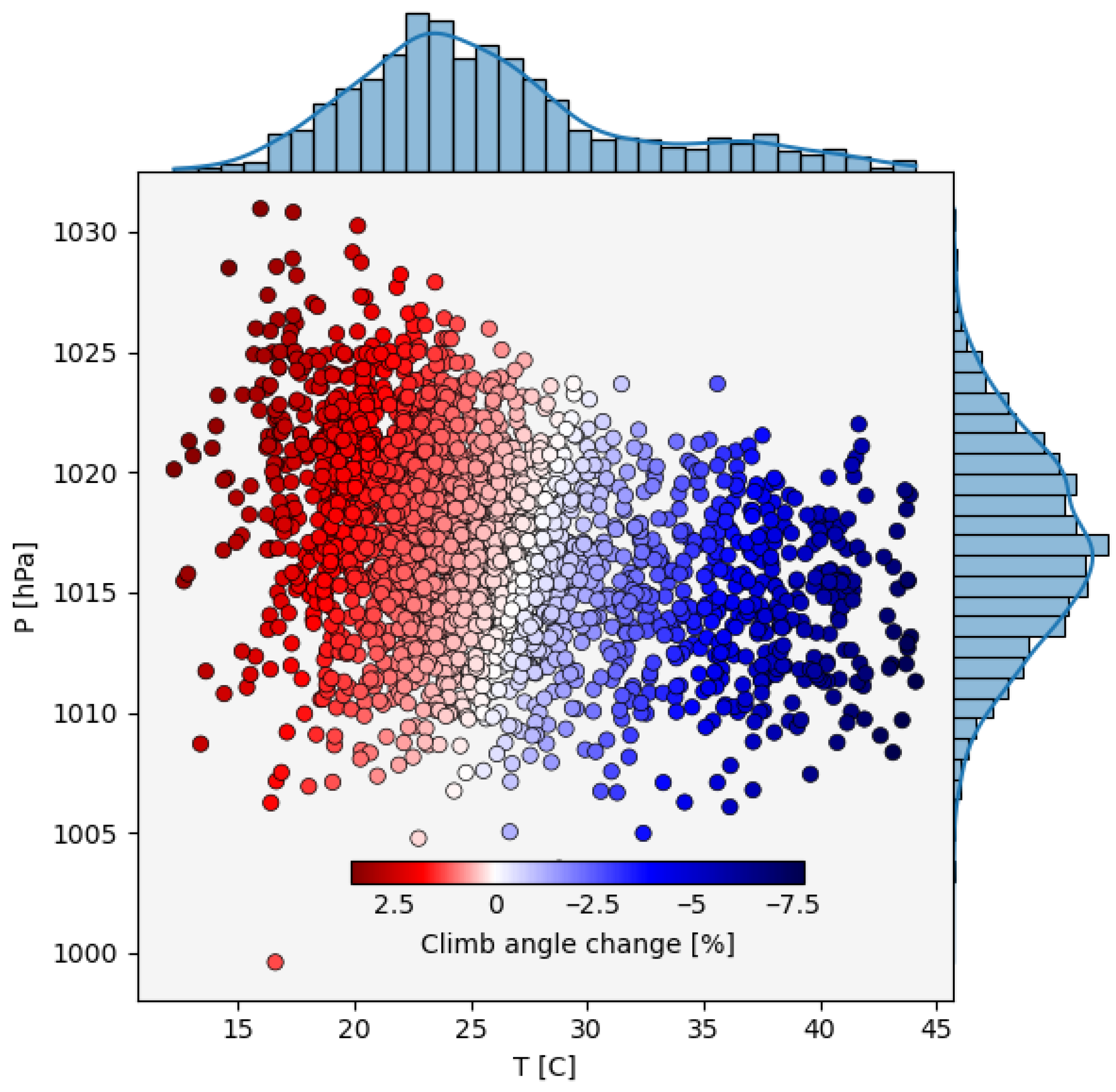
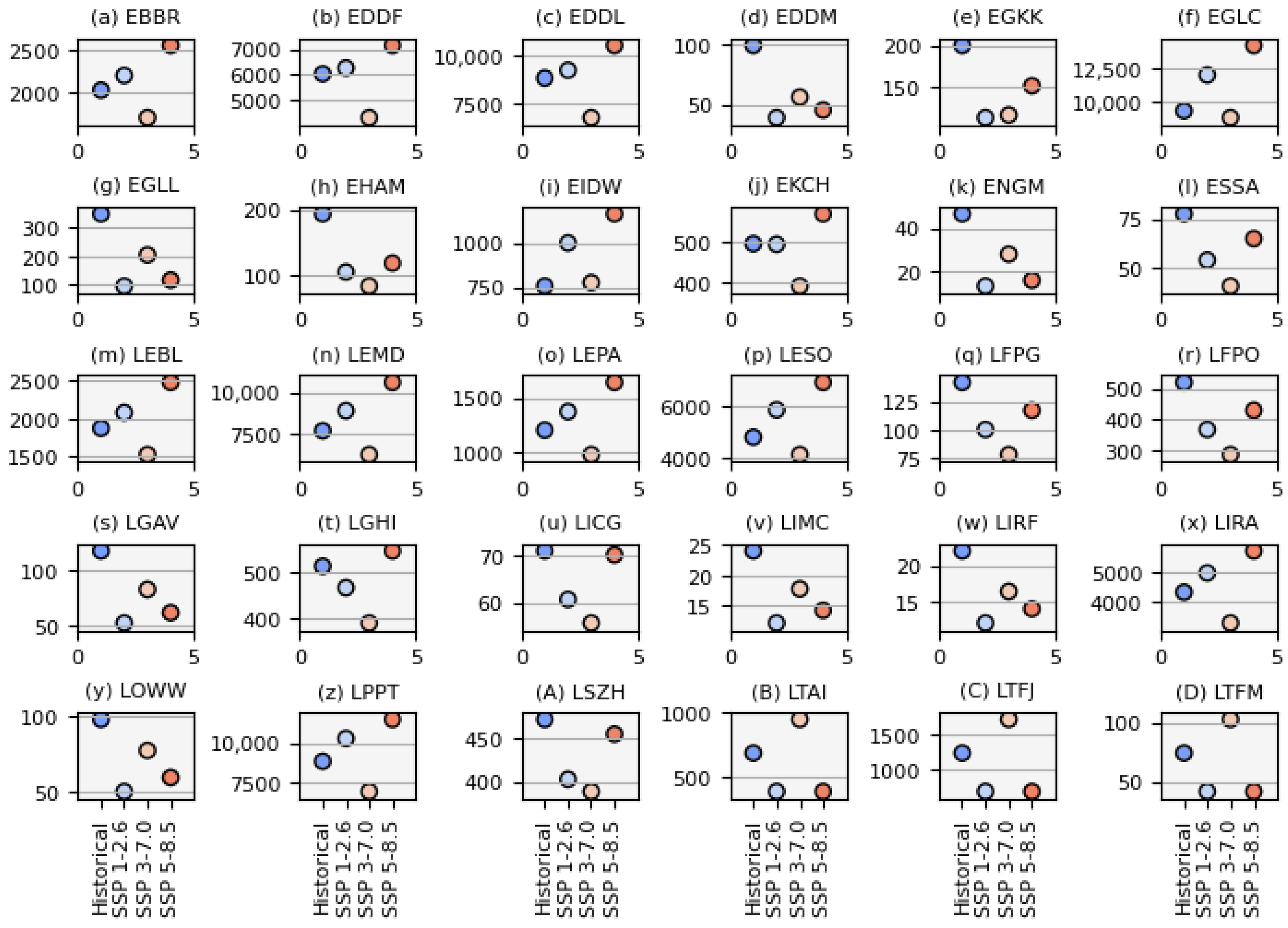
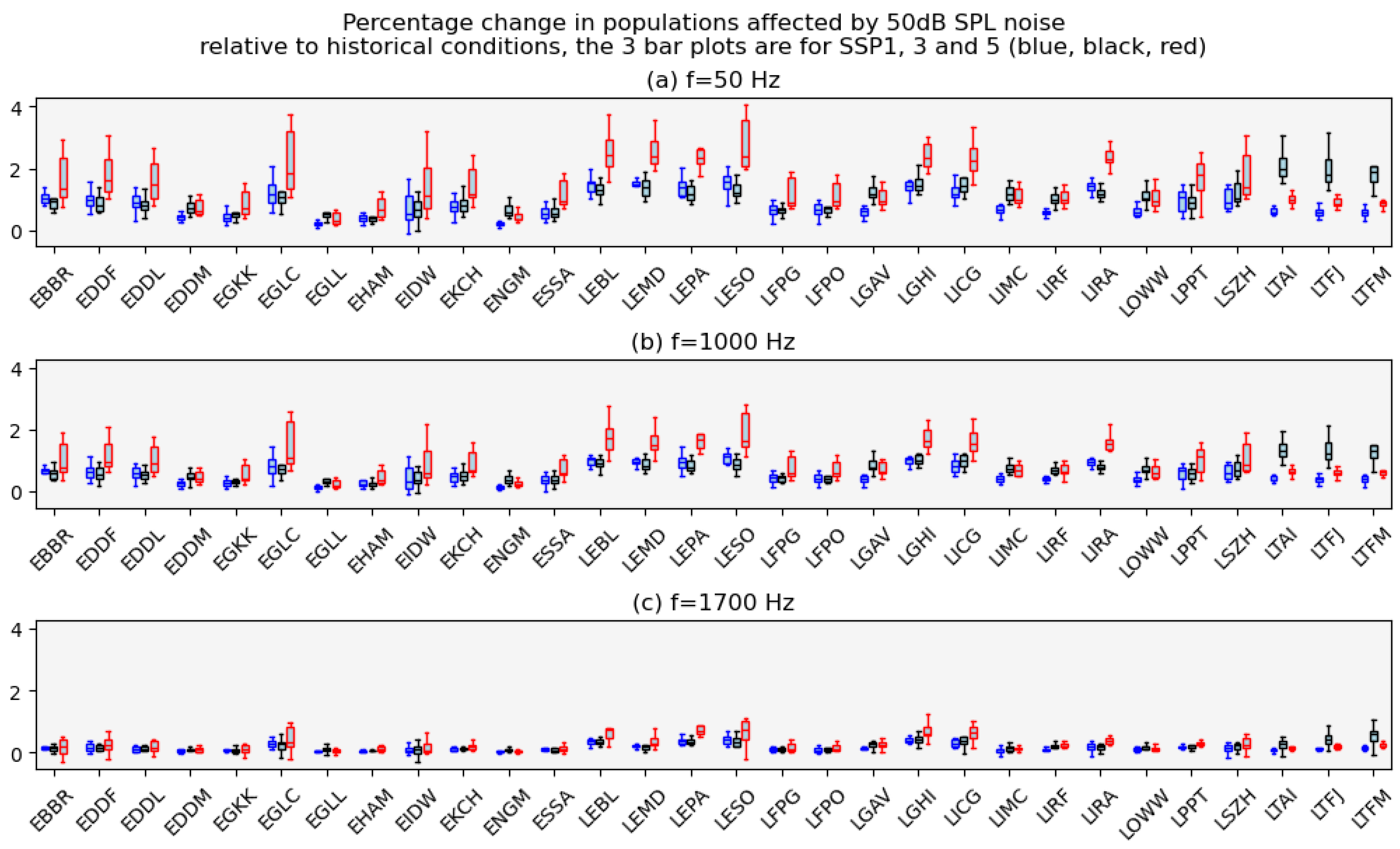
| Parameter | Value | Unit |
|---|---|---|
| 98.90 | dB | |
| 20 | degrees | |
| 31.8 | degrees | |
| 7.25 | degrees | |
| 4.82 | ||
| 4.71 | ||
| mx2t24 | 20.06 | K |
| 1019.1 | hPa | |
| [40] | 11.2 | m |
| [1] | 3902 | m |
Disclaimer/Publisher’s Note: The statements, opinions and data contained in all publications are solely those of the individual author(s) and contributor(s) and not of MDPI and/or the editor(s). MDPI and/or the editor(s) disclaim responsibility for any injury to people or property resulting from any ideas, methods, instructions or products referred to in the content. |
© 2025 by the authors. Licensee MDPI, Basel, Switzerland. This article is an open access article distributed under the terms and conditions of the Creative Commons Attribution (CC BY) license (https://creativecommons.org/licenses/by/4.0/).
Share and Cite
Williams, J.; Williams, P.D.; Venturini, M.; Padhra, A.; Gratton, G.; Rapsomanikis, S. The Impacts of Climate Change on Aircraft Noise near European Airports. Aerospace 2025, 12, 815. https://doi.org/10.3390/aerospace12090815
Williams J, Williams PD, Venturini M, Padhra A, Gratton G, Rapsomanikis S. The Impacts of Climate Change on Aircraft Noise near European Airports. Aerospace. 2025; 12(9):815. https://doi.org/10.3390/aerospace12090815
Chicago/Turabian StyleWilliams, Jonny, Paul D. Williams, Marco Venturini, Anil Padhra, Guy Gratton, and Spyridon Rapsomanikis. 2025. "The Impacts of Climate Change on Aircraft Noise near European Airports" Aerospace 12, no. 9: 815. https://doi.org/10.3390/aerospace12090815
APA StyleWilliams, J., Williams, P. D., Venturini, M., Padhra, A., Gratton, G., & Rapsomanikis, S. (2025). The Impacts of Climate Change on Aircraft Noise near European Airports. Aerospace, 12(9), 815. https://doi.org/10.3390/aerospace12090815










